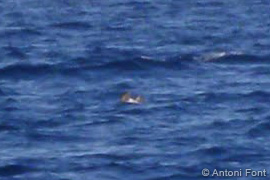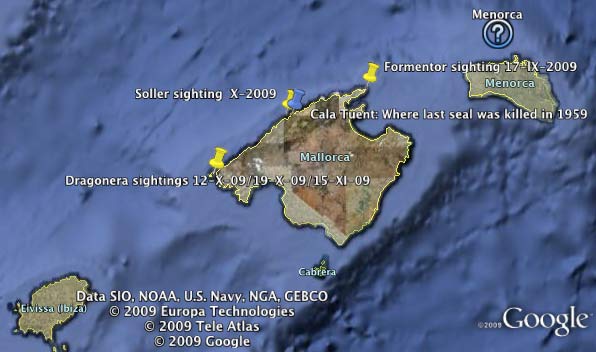Mallorca’s lone seal: the 2009 follow-up
Antoni Font and Joan Mayol
Servei d’Espècies Protegides, Conselleria de Medi Ambient, Govern de les illes Balears
Following the encounter of a monk seal by a diver in an underwater cave on Mallorca in the summer of 2008, an information and monitoring campaign lasting one month was organized, as reported previously in TMG [Sighting and Response, TMG 11 (2): November 2008].
The initiative provided relevant information about new sightings. Also, the deployment and operation of automatic cameras in some caves in the area was tested (Automatic cameras to be installed in Mallorcan caves, TMG 12 (1): June 2009). This proved useful and promising for the future use of this equipment, though unsuccessful in confirming the presence of seals. The equipment was dismantled pending future reinstallation in a specific cave, where sufficient evidence of occupation is detected.
In early summer 2009 there were no reliable data on the presence of monk seal individuals. It was for this reason that the envisaged information campaign and active collection of information among seafarers was not launched this year.
Nevertheless, since the close of the 2008 information campaign, we have received five reports of sightings, described below. One, in early summer, could not be considered reliable, and proved impossible to trace. The three locations where the four remaining observations took place cover a range of 90km along the north coast of Mallorca (Formentor, Soller 40km west, and Dragonera a further 45km).
Map of Balearic Islands.
For more detailed locations download the Google Earth kmz file: “foca observacions”.
- In mid-June 2009 confusing information was received concerning a sailor who had observed two seals at Menorca. The chain of reporting informants was broken and the sighting proved impossible to verify.
- On September 17 a tourist guide spotted a seal from the cliffs of the lighthouse at Formentor. Through several informants, we managed to contact him. The sighting occurred at midmorning from the lighthouse, at an altitude of 120m above sea level. He observed, for about 5 minutes, a dark brown animal that swam and dived repeatedly at a distance from the cliffs of 100-200m. The man had seen dolphins frequently and this animal did not behave like one. The observation ended when some recreational boats appeared in the area, and the animal dived into the deep.
- One day in the first week of October, at noon, the skipper of a tourist boat covering the Sa Calobra - Sóller trip in rough seas and a west wind, briefly glimpsed from the bridge, about 15m away, the back of an animal plunging a few meters from the bow. He claims to have seen clearly the brown back and hind flippers when the animal submerged, which he describes as “different from any cetacean that I see: it was a seal”. The sighting lasted a few seconds. Sea conditions prevented him from turning or staying idle to watch, so he did not observe the animal again. This sighting was made only 2.5km away from the place where the last seal was killed, in 1959, and it is one of the few areas along the coastline of Mallorca that has suffered very little coastal transformations in the last 50 years.
- On 12 October at 11.50, Peter Borkenhagen, an experienced German zoologist who was walking in the Parc Natural de Sa Dragonera, saw a seal swimming with two dolphins. The animals were 300m from him, in the harbour area. They came from the vicinity of the reefs known as ‘els Calafats’ and swam at a distance of between 50 and 100m from the coast in a SW direction. With his powerful binoculars he could clearly see the head of a pinniped, its characteristics and behaviour clearly different from those of the dolphins that accompanied it. Experienced in seeing different species of pinniped, he had no doubt that this one was a monk seal. He made two observations separated by a few minutes – about 20 minutes in total – until the animal rounded a cape and he could no longer follow the swimming group. During this time the seal did not dive, and its way of swimming seemed fatigued. Mr. Borkenhagen is preparing an article for the annual magazine of the Natural History Society of the Balearic Islands.
- A week later, October 19, Juan Miguel Gonzalez, an ornithologist engaged in a bird ringing campaign in the Parc Natural de Sa Dragonera, may have observed the same individual. Despite using 8x binoculars, and the fact that the animal was about 1000m away from the shore and could not be observed in detail, he twice spotted the animal’s back and head. He was certain this was indeed a pinniped. The informant is a reliable field naturalist: he worked for years with environmental education and information gathering summer projects in the Maghreb countries with FFM (Fondo de la Foca del Mediterráneo). During these campaigns he observed repeatedly Monachus monachus individuals. The indications provided (estimated distance and bearing) are coincident (within an error of +- 200m) with the location of a popular diving spot: a sunken wooden fishing boat hosting many big morays and congers. Divers also used to feed fishes here, so the seal should have an easy catch. Some underwater videos of this site, where it’s likely that the seal found food in abundance, are shown on Youtube.
The closest recent sighting (in time and distance) to the Cape of Formentor occurred at the Italian island of Giglio, 700km east, June 7, 2009 [Monk seal sighting at Giglio Island, TMG news blog].
Given the great distance involved, and the short space of time between the observations in Mallorca and Giglio, it is likely that the animal repeatedly observed in 2009 along the north coast of Mallorca is the same that was observed in Mallorca in 2008. Accordingly, we now work on the basis that an individual is present along an extensive (100km) stretch of the north coast of Mallorca. Reports on sightings are occurring at a rapid pace, although the high mobility of this individual makes it impossible to determine a specific spot where it is resting.
Postscript by Antoni Font
|
 |
|
Rear flippers of the diving seal. This is a detail of the picture at full resolution.
|
On Saturday 14 November, a group of 3 persons, myself and 2 friends, left Palma for a sailing weekend on board a 40' yacht owned by a friend who has decided to sell it in coming days. The first intention was to give a farewell to the boat, but we then decided to spend some time around the area where the monk seal has been sighted during recent months, paying special attention to the waters around the Conger Eels wreck at Sa Dragonera. We approached the area under sail on Sunday 15 November around 10:00. During the trip we observed various species of seabirds (Calonectris diomedea, Phalacrocorax carbo, Puffinus yelkouan, Larus michahellis, Sula bassana...). The wind was slight, about 7kts from the south and the sea calm, though slightly rippled. Just as we were arriving at the location, we saw the head of the seal at about 500m distance. Approximate locations of the animal / wreck / observation point are shown in the Google map kmz file. The three points fit in a 300m radius. The observation lasted about 20 seconds and then the animal dived.
It was possible only to take a single picture, that I suspect will not seem conclusive to many, but it's all we managed. We remained in the area for one hour and then circumnavigated the island and visited a spot in the close-by island of Mallorca where a suitable cave was identified during the 2008 survey. The tour was again made under sail, engine off, but we were not lucky enough to see the animal again. We then returned to Palma, on the way observing a group of 5-7 dolphins a mere 5 km from Sa Dragonera.
|




